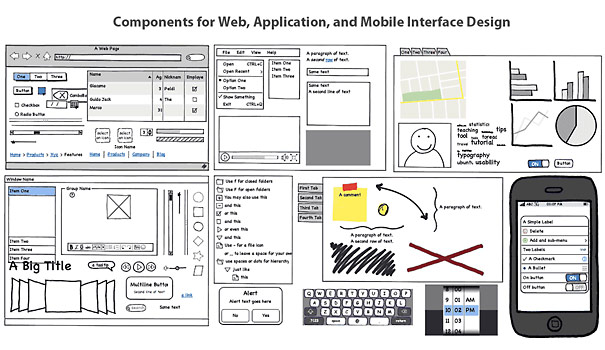
Over the past ten or so years, the technology that we use in our personal lives has taught us two valuable lessons about user experience, probably without us knowing it. First, a great user experience is almost as important as strong functionality; and second, we don’t typically get a positive user experience at work. Websites, smartphones, tablets and apps from companies like Apple and Google provide useful and intuitive tools that help us meet life’s daily challenges. However, when we think about our business challenges, we find technology that is often burdensome and hard to use. And, we end up using these technologies because we have to, not because they help us.
Our goal with this article is to convince business users in the equipment finance industry that you not only can, but must take control of the technology you use. In other words, don’t accept mediocrity in your business’s technology systems.
This article will describe a visual tool called a wireframe that will enable you to leverage your experience with technology at home to drive and develop better technology tools for your business.
If a picture is worth a thousand words, then a wireframe is worth a thousand requirements. A wireframe is a mocked up representation of the functionality, content and flow of a work screen and/or process flow within your business. They can be easily linked to other wireframes to capture a business’ full processing and data capture requirements.
In our previous article, Process Mapping – Setting a Course for Success, we discussed how process maps can support your business by freeing your experts to be innovative and drive process improvements. Wireframes document those innovations and enhancements through pictures and examples. Instead of trying to describe complex ideas through words, wireframes visualize how processes, data and business rules come together to support the flow of transactions through your business. A significant benefit of wireframes is they empower business users to convey what they want the user experience to be, often through applying examples from other applications they have used in either their personal or business lives. Wireframe tools such as Balsamiq (www.balsamiq.com), shown in the figure below, enable business analysts and users to collaborate to create wireframes that define the right user experience.

Importance of Wireframes
Now that we have defined what a wireframe is, we will describe how utilizing wireframes is crucial to businesses within the equipment finance industry. The industry is essentially undertaking a technology refresh and we maintain that focusing on the business user’s experience and weaving the use of wireframes into gathering and understanding each business function’s requirements and deliverables is essential to executing this transformation successfully.
Wireframes result in better systems because they:
- Improve communication between business and technology teams
- Improve time efficiency
- Enable empowered engagement with users
- Increase satisfaction of employees supporting these projects (perhaps surprisingly)
As we all have experienced, the relationship between business and technology teams can often be one where the business team expects more from their technology team, while technology teams feel the business team is not being clear about their expectations. Wireframes help to bridge that disconnect. The complexity and nuances of an equipment finance business from operations to sales to portfolio management is difficult to convey. As a result, there is mutual frustration between the functional roles. Improved communications through the use of wireframes allows professionals to express requirements and set expectations in a way that they are understood by all.
In addition to being a communication tool, wireframes are also highly efficient because the amount of time needed to review a picture or user journey is much less than the amount of time needed to review words in a document. Frequent and productive reviews of the wireframes ensure they capture complexities and nuances of the business processes, while saving time. This efficiency allows our projects to finish faster and with greater business satisfaction.
The empowerment of team members is another key benefit of wireframes. The wireframes empower the technology users to take ownership of their user experience using examples from their personal or business lives. This empowerment helps to drive buy-in and enable an easier change from the existing process to the new process. Wireframes also empower technology teams to find and build the technology that best fits the needs of business users rather than having to guess about what business users will need. This empowerment creates a sense of ownership both from the business and technology teams that aligns best with the skillsets of those teams.
Lastly, the satisfaction of working on a project that uses wireframes tends to be higher than projects using only words in documents. Most people fundamentally like to work with pictures and examples. Largely through the previously described benefits, projects that use wireframes to express business requirements experience better morale and engender a feeling that we are making progress in the transition to a more efficient system – typically a pressure packed situation. Transformational systems overhauls are always pressure packed. In that context, greater satisfaction and better morale have a positive impact on the project and are critical to making it through the inevitable tough problems.
Wireframes Done Right
Now that we understand what wireframes are and how they benefit our business, we will describe how one can “do wireframes right.” Two things are essential to maximizing the benefit of wireframes. First, the users must be engaged and engaged properly. Second, the wireframes must be built properly. They must be linked to depict the user journey through the system and richly annotated to provide greater context.
A key to doing wireframes right is setting up the right sessions to drive out what business users need in order to effectively communicate the business solution. These sessions build on the understanding of the process described in our previous article and focus on what the business needs to support and improve the process. Successful wireframe sessions capture how the process should be, what data is needed at each step and the user experience desired.
The initial sessions consist mostly of brainstorming sessions that capture the needs at an abstract level built upon past business and personal experience. Iterative reviews of updated wireframes follow quickly. A critical success factor is that review sessions happen quickly to ensure the ideas and thoughts captured in previous sessions are fresh in the minds of the people involved. The review sessions continue until the wireframes capture participants’ needs early and accurately.
The last part of the engagement model is independent review. Users should be enabled and encouraged to go through the wireframe prototypes themselves, on their own. This will truly test whether the screens are intuitive and flow correctly. These tests often yield the most constructive feedback.
Fundamental to effective wireframe review, particularly independent review, is the creation of a wireframe based prototype that links the wireframes together to accurately convey the user experience and workflow. Samples of data entry and clicking links and buttons evokes a three dimensional view into the end result of the project. That’s really powerful. The business user actually knows what to expect, which is impossible in textual requirements, no matter how good.
Where text shines is in annotations to the wireframes. Annotations are notes that capture nuances in business process and business rules. The annotations are captured directly on the wireframe so that the technology user’s experience and nuances are captured in one place. Annotations can also be used to provide a rich understanding of the types of data captured, their values, and ultimately the data’s “behavior” within the system. In combination with the click through linking of wireframes, annotations can also highlight field dependencies and interaction.
The final resulting wireframes visualize how each step of the process should look, the data needed at each step, the interaction between the wireframes and nuances captured through annotations.
Conclusion
We are at a fascinating moment in time where our experiences with technology in our personal lives have provided great examples of user experiences that are both useful and intuitive. We need to leverage that experience to drive what we want from our systems at work. Wireframes done right express our wants in a way that makes sense to both the business and technology teams. The result is clear communication, efficient execution, empowerment of business and technology teams and greater employee satisfaction. As with process maps done right, wireframes done right will become an asset to your business. We urge you to own your user experience at work by using wireframes.
See also: Process Mapping -- Setting a Course for Success.